COOPERATION MODEL
ARTIFICIAL INTELLIGENCE
PRODUCT ENGINEERING
DevOps & Cloud
LOW-CODE/NO-CODE DEVELOPMENT
INDUSTRY
FRONTEND DEVELOPMENT
CLOUD DEVELOPMENT
MOBILE APP DEVELOPMENT
LOW CODE/ NO CODE DEVELOPMENT
EMERGING TECHNOLOGIES







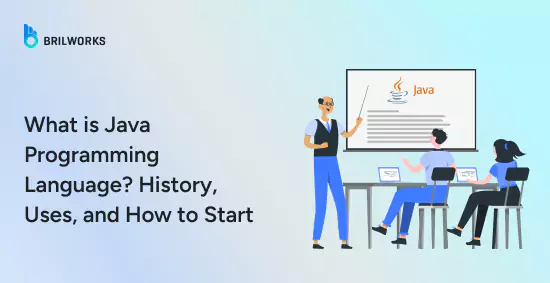
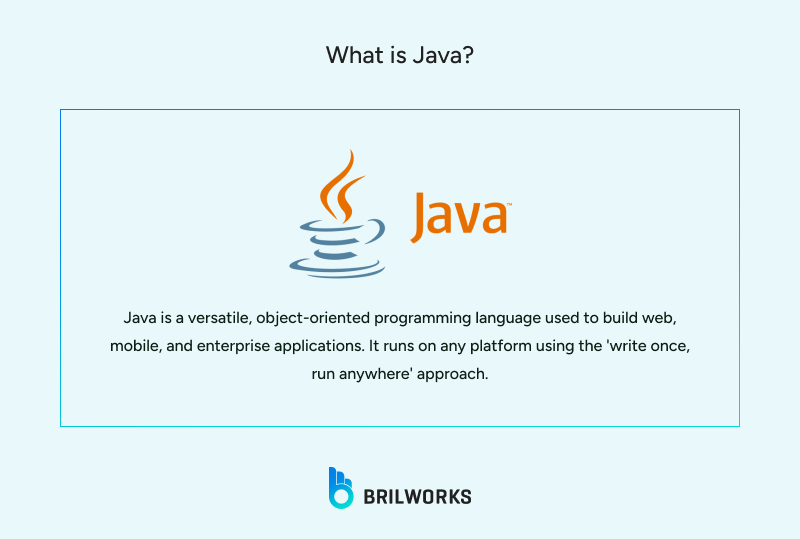
Java, introduced by Sun Microsystems in 1995, is a flexible, object-oriented programming language now maintained by Oracle.
At its core, Java provides a structured set of rules and syntax that enables developers to create instructions for computers to execute. Furthermore, Java is also well-known for its "write once, run anywhere" philosophy. Which means you can run the Java code on almost any device that has the Java Virtual Machine (JVM) installed. We will cover Java technologies, such as the JVM, later in this blog.
Java is strongly typed, meaning you must specify what kind of data you are working with (numbers, text, etc.), and it's object-oriented, which means it organizes code around "objects," self-contained units that combine data and functions that operate on that data.
The language uses a syntax similar to C and C++, making it familiar to many programmers, but it removes many of the complex features that make those languages difficult to learn. Java automatically handles memory management through garbage collection, which prevents many common programming errors.
Essentially, Java is a tool that translates human-readable code into instructions that computers can execute, with the added benefit of being platform-independent and designed for building robust, scalable applications.
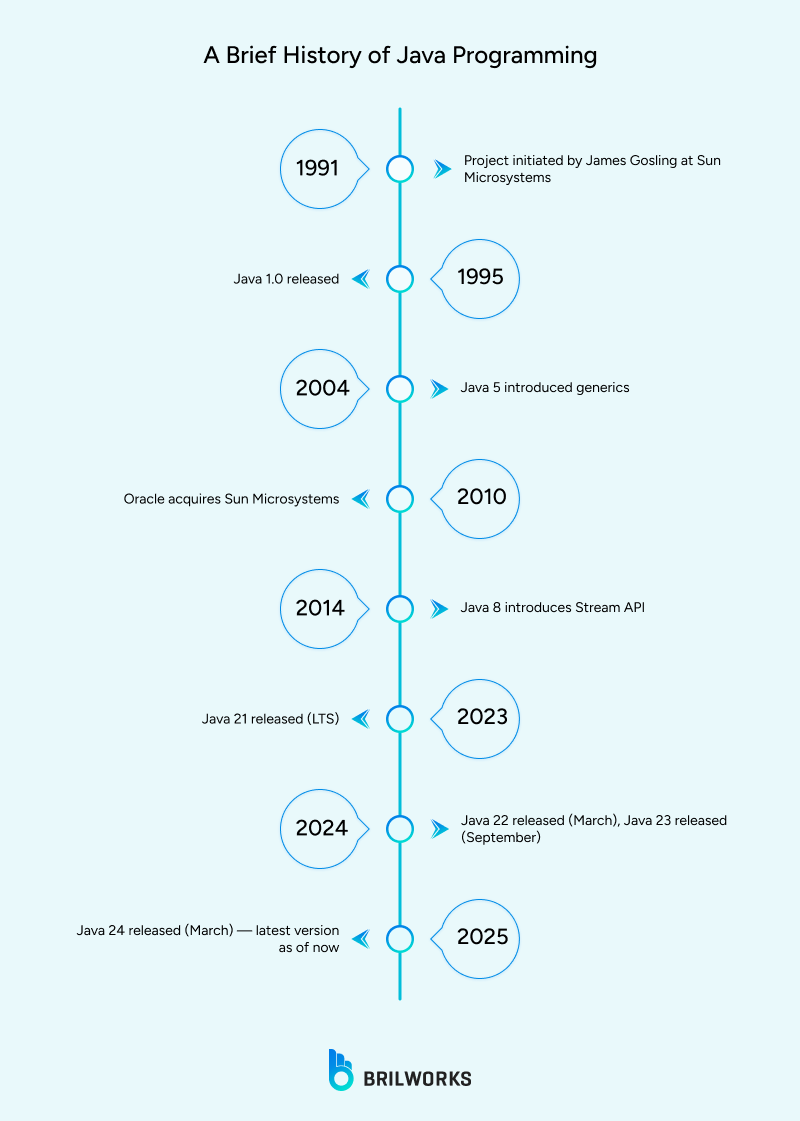
Java's story begins in 1991 at Sun Microsystems when James Gosling and his team started working on a project called "Green Project." Originally, they were developing software for consumer electronics like set-top boxes and televisions. The language was initially called "Oak." The name was trademarked, so later they changed it to "Java."
In 1995, the internet was exploding in popularity, and Sun Microsystems realized Java's potential for web development. They officially launched Java with the slogan "Write Once, Run Anywhere." The first public release was Java 1.0, which introduced the revolutionary concept of platform independence through the Java Virtual Machine (JVM).
Released in 1997, Java 1.1 brought key enhancements such as inner classes, JavaBeans support, and JDBC for connecting to databases.
In 1998, Java reached a significant turning point with the release of Java 1.2, which introduced the Swing GUI toolkit and the Collections Framework. This version, referred to as the "Java 2 Platform," introduced three separate editions: J2SE for standard use, J2EE for enterprise-level applications, and J2ME for mobile and embedded systems.
Then came Java 1.3 in 2000 and Java 1.4 in 2002. Another noteworthy update was released in 2004 with Java 1.5. This version was renumbered to Java 5.0 to reflect its importance.
In 2006, Java 6 came with a focus on performance improvements and included scripting language support.
Oracle took over Java's development in 2010 after acquiring Sun Microsystems, and the next major release, Java 7, followed in 2011.
Then, in 2014, came Java 8. The Java version that introduced lambda expressions, streams, and functional programming features. Surprisingly, this version is still widely used today.
Java 9, released in 2017, introduced the module system and initiated Oracle’s shift to a six-month release schedule for future Java versions.
Java 10 (2018): Introduced the var keyword for local variable type inference.
Java 11 (2018): Marked as a Long-Term Support (LTS) release with key features like a new HTTP client and string improvements.
Java 17 (2021): Current LTS release with features such as sealed classes and enhanced pattern matching.
Java 21 (2023): the latest LTS version, brought major updates like virtual threads and enhanced switch pattern matching.
Java 22 to 24 (2024–2025): Continued incremental improvements with multiple new features enhancing performance and developer experience.
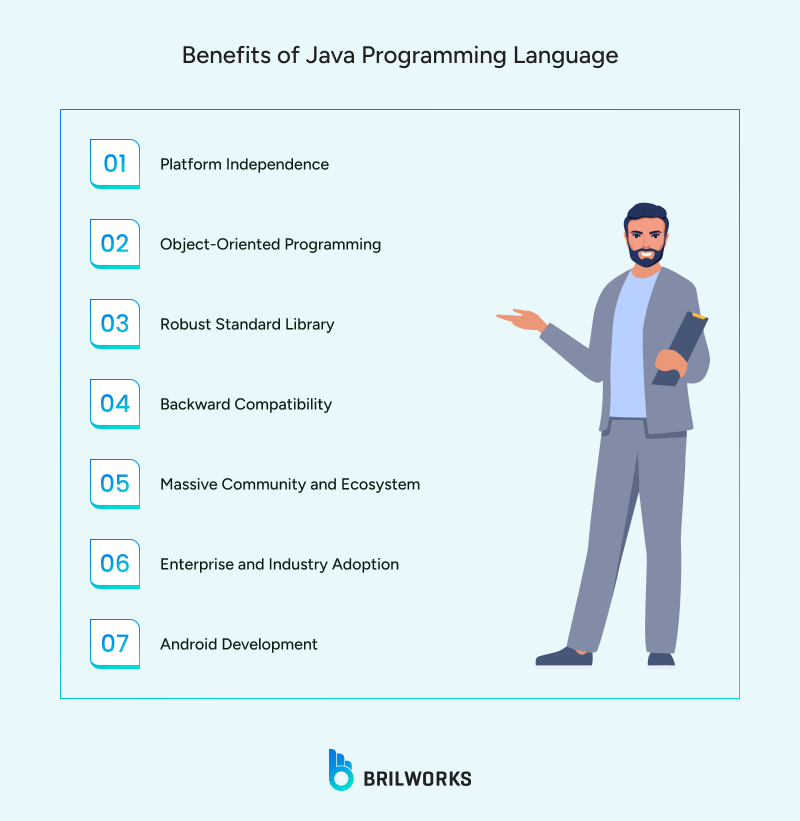
Java has maintained its position as one of the world's most popular programming languages for nearly three decades. According to reports, currently Java is the fourth most popular programming language in the world.
Here are the key reasons why developers and organizations continue to choose Java:
"Write Once, Run Anywhere" Java's biggest advantage is its platform independence. Code written on Windows can run seamlessly on Mac, Linux, or any other operating system without modification. This is achieved through the Java Virtual Machine (JVM), which acts as a translator between your Java code and the underlying operating system.
Being object-oriented, Java encourages modular code that can be reused and maintained with ease. Complex applications can be broken down into manageable objects that interact with each other. For beginners, it also introduces good programming habits right from the start.
Data structures, networking, file I/O, cryptography, and more are all covered by the extensive collection of built-in libraries that Java includes. Because it offers ready-to-use functionality, this extensive library support speeds up development.
Backward compatibility is a top priority for Java, guaranteeing that older programs can continue to function on more recent iterations of the language with little to no modification. Java is trusted for enterprise systems where stability is crucial in large part because of its consistency.
Java has one of the largest and most active developer communities globally, offering easy access to countless tutorials, forums, open-source libraries, and detailed documentation. It's likely that someone has already asked—and responded to—your question.
Java is the foundation of many sectors where dependability and long-term support are important, including banking, insurance, healthcare, and government. Java's enduring relevance is guaranteed by its dominance in enterprise development (through Java EE or Jakarta EE).
Java is one of the primary languages for Android app development, giving it a strong foothold in the mobile ecosystem. While Kotlin is gaining popularity, many Android apps still rely heavily on Java libraries and codebases.
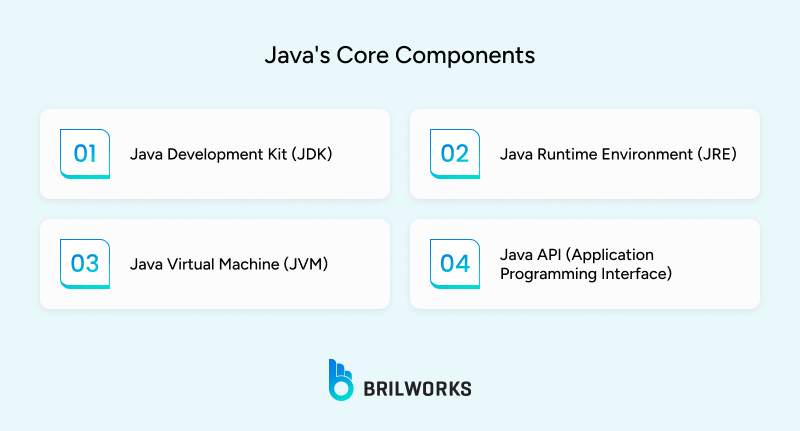
Let’s now explore the fundamental components that make up the Java programming platform. Before writing any code, it's essential to understand what makes up the language itself. Java is a complete ecosystem made up of key components that work together to help you manage applications.
Let's break them down:
Think of the JDK as your complete toolbox. It includes the core tools and libraries developers need to create applications in Java.
Compiler (javac) – Translates your human-readable Java code into bytecode.
Java libraries – Pre-written code for handling common tasks like input/output, data structures, and networking.
Tools – Includes utilities like javadoc for generating documentation and jarsigner for signing applications.
You'll install the JDK when you’re ready to start coding in Java.
While the JDK is for developing Java applications, the JRE is for running them. It includes:
Java Virtual Machine (JVM) - More on this below.
Core libraries - The essential packages your code depends on.
If you only want to run a Java application (not build one), the JRE is all you need.
The JVM is the secret behind Java's philosophy of running the same code on any device. It reads your compiled Java bytecode and translates it into machine-level code that your operating system understands.
Every device or platform (Windows, macOS, Linux, etc.) has its own version of the JVM. But because the bytecode stays the same, your Java program works everywhere.
The Java API is a vast library of prewritten classes and methods. It covers everything from basic data types (like strings and lists) to complex tools for networking, file handling, and user interfaces.
Instead of building everything from scratch, you can rely on the Java API to handle common operations securely.
Also read: What You Need to Know About Java Packages
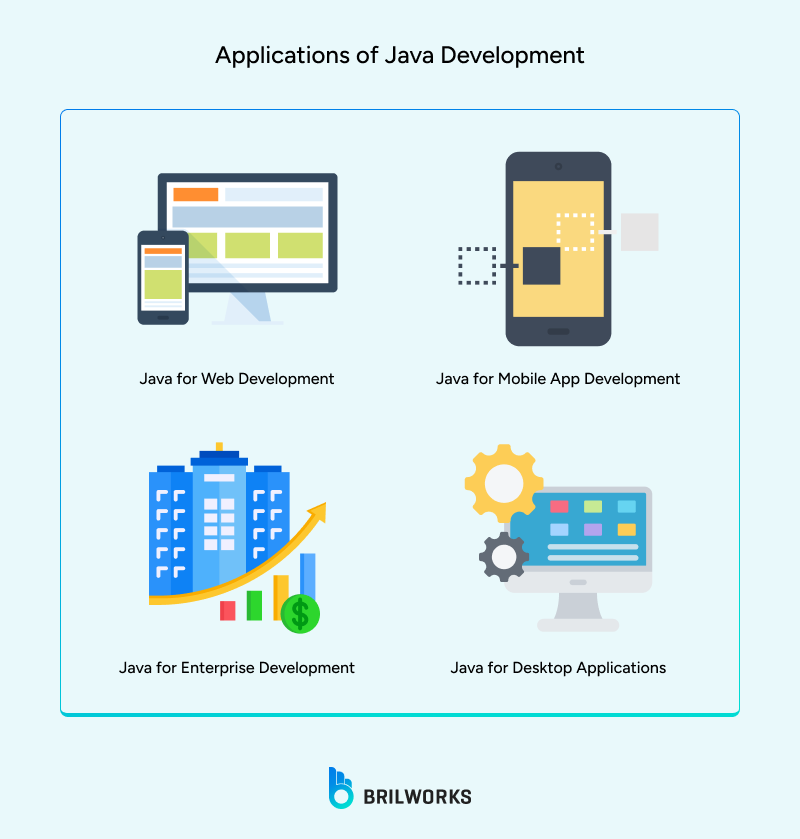
Java's versatility and robust architecture have made it a cornerstone technology across numerous industries and application domains. Here's a comprehensive look at where Java is actively used:
The back-end of contemporary websites and web apps heavily relies on Java. It manages server-side logic, the back-end operations that enable web apps to function, but unlike HTML or JavaScript, it is not visible in the browser.
Popular technologies used:
Java Servlets and JSP (JavaServer Pages) – used to build dynamic websites
Spring Framework – a powerful toolkit for building scalable web applications
Java is the foundation of many web applications, ranging from scalable REST APIs to enterprise-level platforms. Developers can quickly create safe, maintainable backend systems with the help of powerful Java frameworks like Spring and Jakarta EE.
Java is the foundational language for Android. So, if you have an Android phone, you have interacted with Java. Although Kotlin is growing in popularity, Android apps are primarily written in Java.
Why Java for mobile?
Java serves as the foundation for the Android Software Development Kit (SDK).
It’s dependable, thoroughly supported, and compatible with a vast range of Android devices.
Java provides enterprise-level tools and security that many companies utilize for their large-scale mobile applications. For example, online banking systems or e-commerce websites utilize Java for their backend. These apps need to handle lots of users, process tons of data, and stay secure and reliable. Java enterprise development uses a special set of tools and frameworks called Jakarta EE, formerly known as Java EE.
Jakarta EE provides APIs and tools for enterprise-level production that many Java development companies utilise.
Java has been a significant player in desktop application development since its early days. Java desktop applications are standalone programs that run on a user's local computer, built using Java's GUI (Graphical User Interface) frameworks. Unlike web applications that run in browsers, these applications are installed and executed directly on the operating system while leveraging Java's cross-platform capability.
While the landscape has evolved with web and mobile applications, Java desktop development remains a viable and valuable skill for specific application domains.
If you're exploring how Java powers real-world business solutions, our [Complete Guide to Java Development Services] offers a deep dive into the service models, strategies, and benefits.
Java's position in the programming landscape is best understood by comparing it with other popular languages. Each language has its strengths and ideal use cases, and understanding these differences helps developers choose the right tool for their projects.
Despite the similar names, Java and JavaScript are different, although both falls under the programming languages category.
The only reason both have similar name is that back in 1995, Java was gaining popularity. To ride the wave, the creators of JavaScript chose a name that sounded similar. Thus, JavaScript.
|
Feature |
Java |
JavaScript |
|
What it is |
A general-purpose programming language used for building full-scale applications |
A scripting language mainly used to make websites interactive |
|
Where it runs |
Anywhere with a Java Virtual Machine (JVM) – Android, servers, desktop |
Directly in your browser (Chrome, Firefox, etc.) |
|
Typical uses |
Android apps, enterprise software, backend systems |
Buttons, animations, form validation on websites |
|
Typing system |
Statically typed (you declare the data type) |
Dynamically typed (the browser figures it out at runtime) |
Now, let's look at another language beginner often consider.
Python is widely loved because its syntax is clean and reads almost like English. In fact, many programming bootcamps start with Python for that reason.
Java, on the other hand, requires more structure. You have to declare your variables, define the main method, and stick to some strict rules.
|
Feature |
Java |
Python |
|
Syntax |
Verbose, structured |
Clean, minimal |
|
Performance |
Faster at runtime |
Slower (interpreted at runtime) |
|
Use Cases |
Mobile apps, enterprise systems, backend services |
Data science, scripting, automation, web apps |
|
Learning Curve |
Steeper at the beginning |
Easier for absolute beginners |
C++ give you deep control over memory and hardware, which is powerful but also risky. It's used in places where performance is absolutely critical, like game engines or operating systems.
Java, in contrast, runs on the Java Virtual Machine (JVM), which handles a lot of that complexity for you.
|
Feature |
Java |
C++ |
|
Memory Management |
Automatic (Garbage Collector) |
Manual (you manage memory) |
|
Platform Dependency |
Cross-platform (JVM) |
Platform-specific unless recompiled |
|
Complexity |
Beginner-friendly |
Steep learning curve |
|
Best For |
Scalable apps, cross-platform development |
Games, embedded systems, high-performance apps |
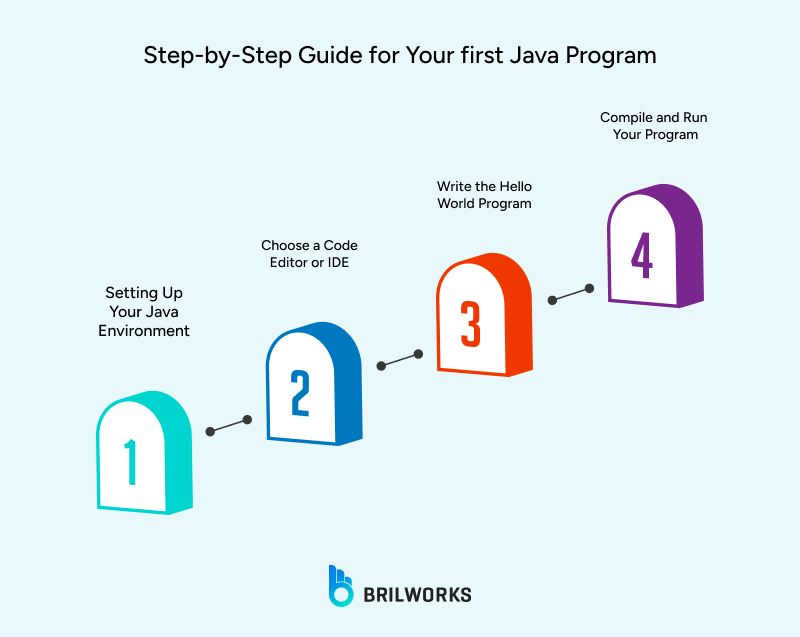
In this section, we'll walk through every step of writing, compiling, and running your first Java program. Let's get started:
First step is installing Java on your system. Java programs are written and compiled using the JDK (Java Development Kit). Here's how to get it:
Visit the official Oracle JDK download page.
Download the latest Java SE Development Kit (JDK) for your operating system.
Follow the installation instructions for your system.
After installing, open your terminal or command prompt and run:
java -versionIf you see a version number (e.g., java version "21.0.1"), you’re good to go!
You'll need a place to write your code. You can start with a simple text editor like Notepad++, or better yet, use a Java IDE (Integrated development environment) designed for Java:
VS Code (with Java extensions)
IntelliJ IDEA Community Edition
Eclipse IDE
For beginners, IntelliJ IDEA is often the easiest to set up and has excellent Java support out of the box.
Let's write the simplest possible Java program. Create a file named HelloWorld.java (Java is case-sensitive, and file names must match the class name). Paste this code into the file:
public class HelloWorld {
public static void main(String[] args) {
System.out.println("Hello, world!");
}
}Let’s break that down:
public class HelloWorld — Defines a class named HelloWorld. Java code must live inside classes.
public static void main(String[] args) — This is the entry point of your program. Java will look for this method and start execution from here.
System.out.println("Hello, world!"); — Prints the message to your screen.
Java code is first compiled into bytecode, then executed by the JVM. Open your terminal or command prompt and navigate to the folder where your file is saved. Then run:
javac HelloWorld.javaThis compiles your code and creates a file called HelloWorld.class.
Now run the program:
java HelloWorldYou should see:
Hello, world!Congratulations! You've successfully created and run your first Java application.
Java, as a programming language, has evolved immensely over the years. It has remained steadfast for the last three decades and will continue to do so. From standard web applications to enterprise development, it has proven reliable.
While learning Java might feel like a huge leap, gradually you will get the hang of it. There is a vast community of Java developers and Java tools out there to help you out. Find resources and experiment. As you move forward in your Java development career, remember that mastery comes through consistent practice and continuous learning. The Java ecosystem is vast and constantly expanding, with new frameworks, libraries, and best practices emerging regularly.
Java is widely used for building web applications, Android apps, enterprise software, and backend systems. Major platforms like LinkedIn, Netflix, and banking systems rely on Java because of its stability and scalability.
Yes, Java remains highly relevant. With ongoing updates from Oracle and strong community support, it continues to power modern enterprise solutions, Android development, and cloud-based applications.
Despite similar names, Java and JavaScript serve different purposes. Java is a compiled, general-purpose language used for large-scale applications, while JavaScript is a scripting language mainly used for interactive web content. They run in different environments and have different syntax and use cases.
Absolutely. Java is often recommended for beginners because of its clear syntax, strong community support, and extensive documentation. With patience and the right resources, it's a beginner-friendly language.
To start, you'll need to install the Java Development Kit (JDK) and an IDE like IntelliJ IDEA, Eclipse, or VS Code. These tools provide the environment for writing, compiling, and running Java programs.
Get In Touch
Contact us for your software development requirements
Get In Touch
Contact us for your software development requirements